Cross-Cultural Leadership: Managing Operations in Tanzania Dam Project
VerifiedAdded on 2023/06/18
|10
|3167
|450
Report
AI Summary
This report examines the cross-cultural challenges faced by Brett Jones, a US-based vice president managing the operation phase of a major dam project in Tanzania. It uses Hofstede's model to highlight differences in organizational culture between Tanzania and the US, focusing on power distance, individualism, masculinity, uncertainty avoidance, long-term orientation, and indulgence. The report also addresses communication and negotiation challenges arising from cultural differences, including the importance of effective communication and understanding of local etiquette. Furthermore, it explores motivation and HRM issues, emphasizing the need for attractive incentives and employee engagement. The report provides solutions for managing these challenges, such as regular meetings, conflict management systems, clear communication strategies, and culturally sensitive negotiation approaches. The aim is to help leaders effectively manage cross-cultural operations and improve employee motivation and project outcomes. Desklib provides similar solved assignments and past papers for students.
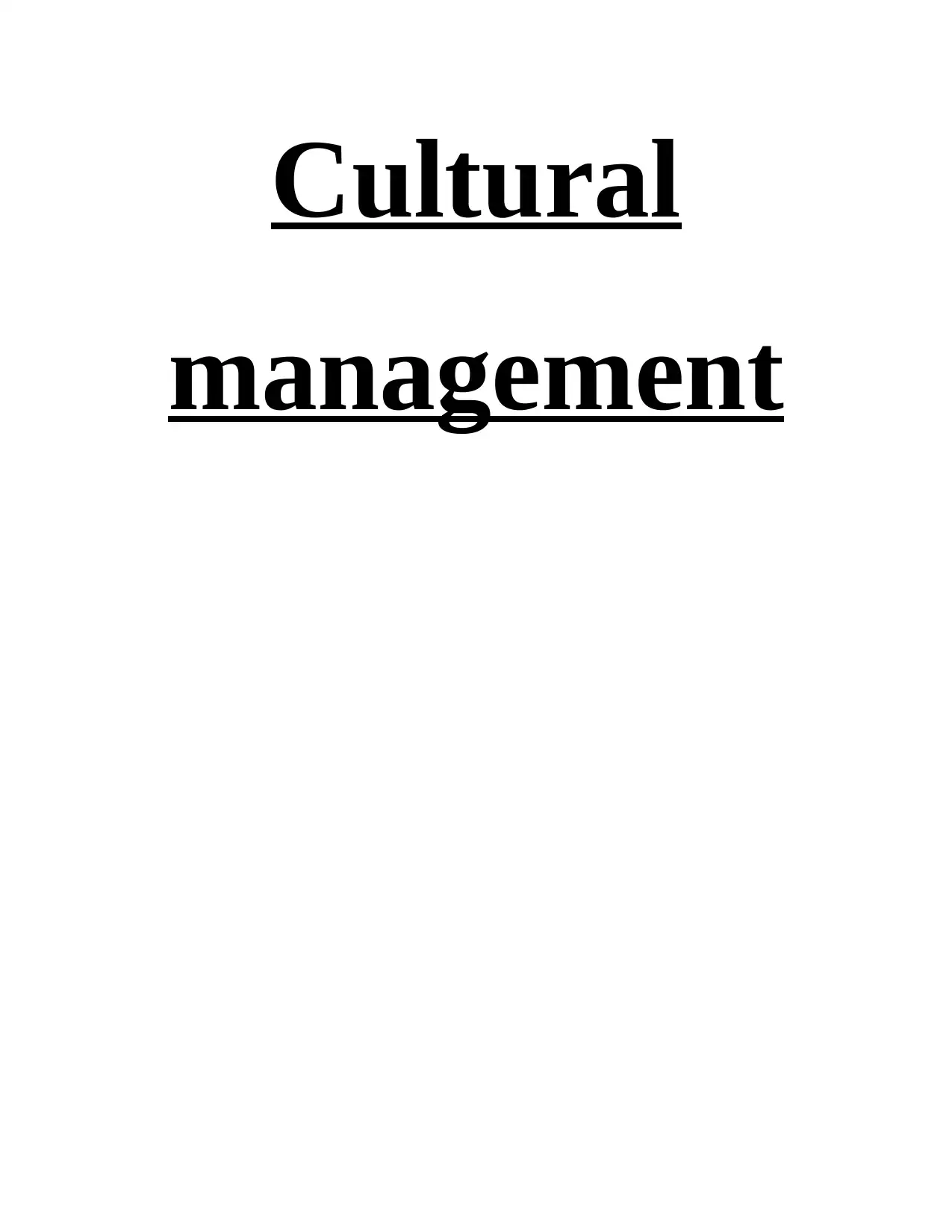
Cultural
management
management
Paraphrase This Document
Need a fresh take? Get an instant paraphrase of this document with our AI Paraphraser
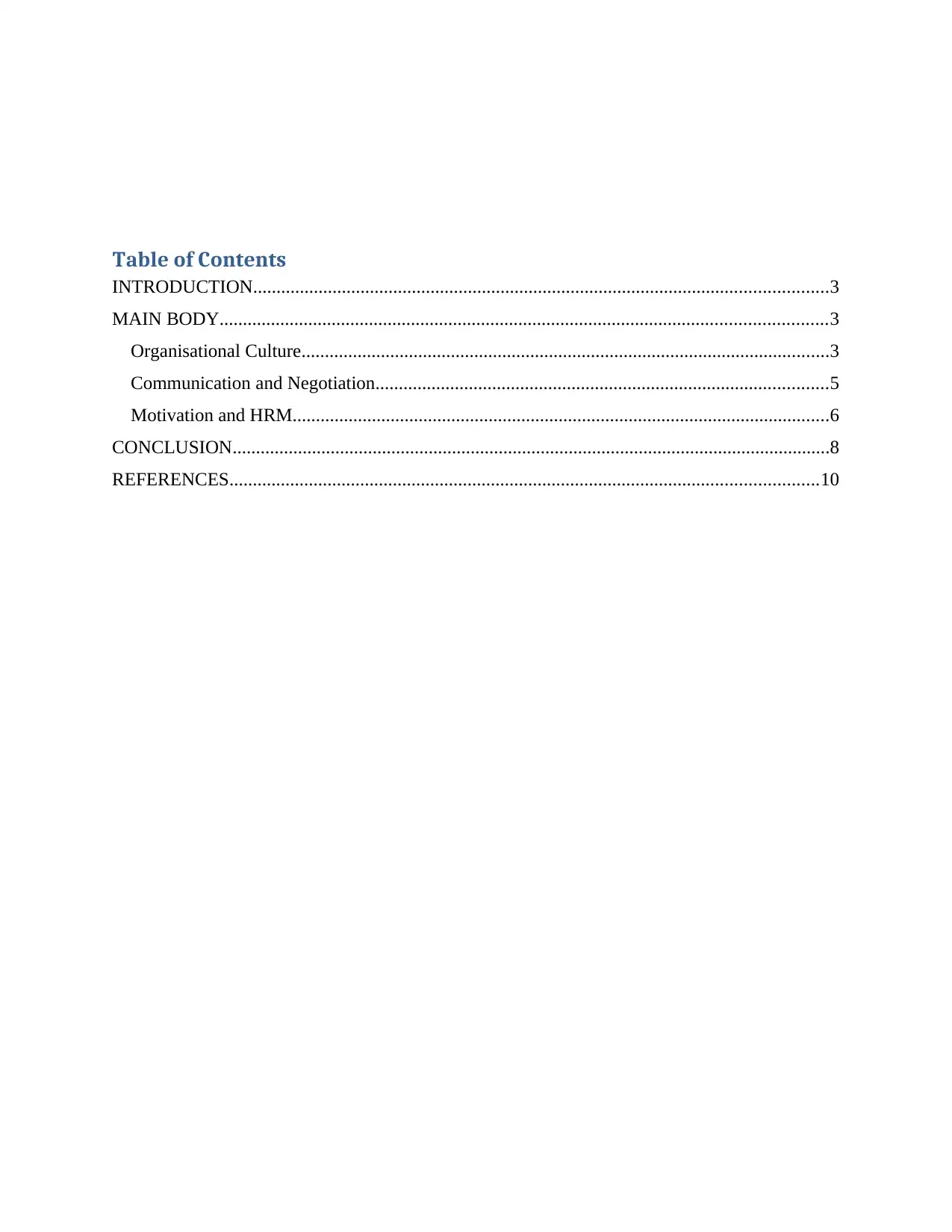
Table of Contents
INTRODUCTION...........................................................................................................................3
MAIN BODY..................................................................................................................................3
Organisational Culture.................................................................................................................3
Communication and Negotiation.................................................................................................5
Motivation and HRM...................................................................................................................6
CONCLUSION................................................................................................................................8
REFERENCES..............................................................................................................................10
INTRODUCTION...........................................................................................................................3
MAIN BODY..................................................................................................................................3
Organisational Culture.................................................................................................................3
Communication and Negotiation.................................................................................................5
Motivation and HRM...................................................................................................................6
CONCLUSION................................................................................................................................8
REFERENCES..............................................................................................................................10
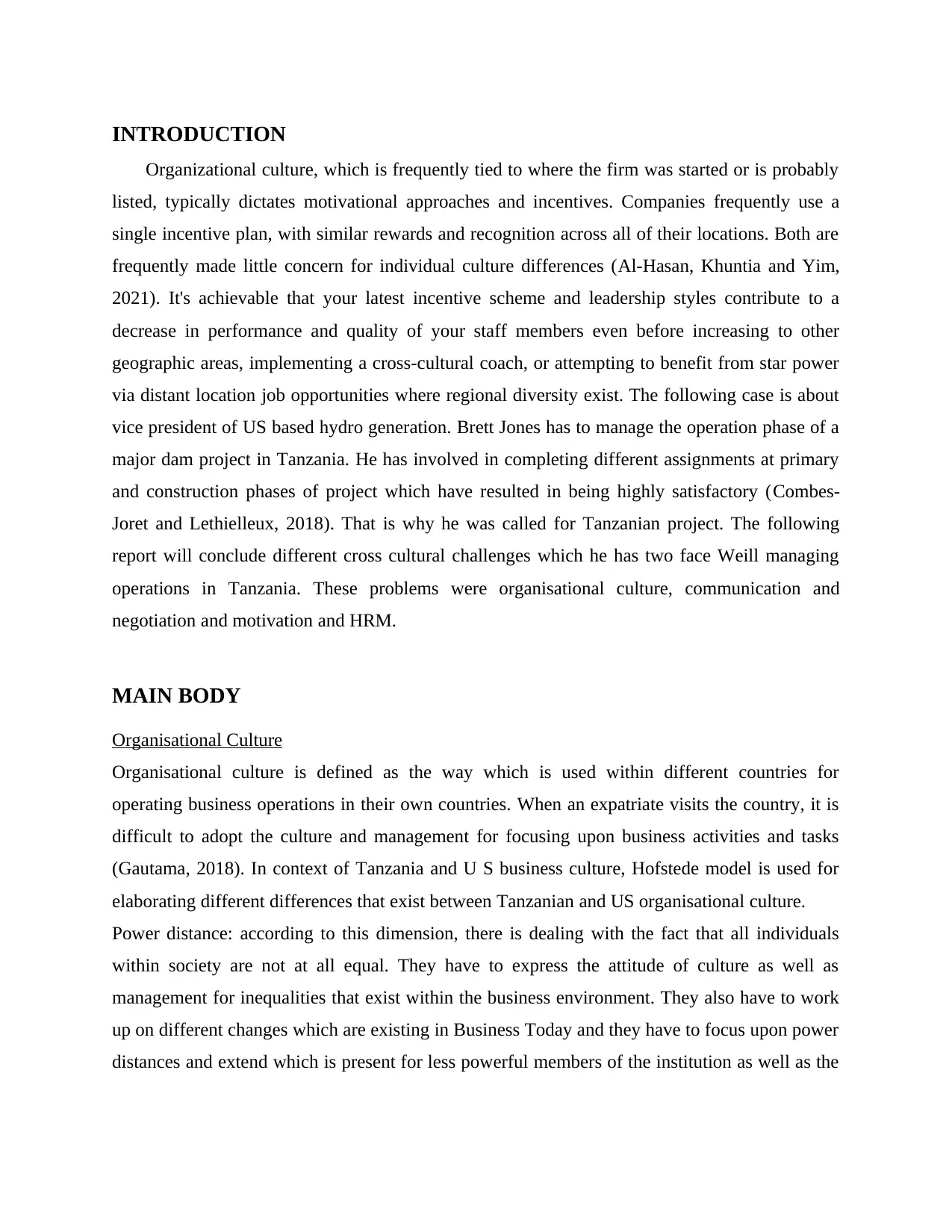
INTRODUCTION
Organizational culture, which is frequently tied to where the firm was started or is probably
listed, typically dictates motivational approaches and incentives. Companies frequently use a
single incentive plan, with similar rewards and recognition across all of their locations. Both are
frequently made little concern for individual culture differences (Al-Hasan, Khuntia and Yim,
2021). It's achievable that your latest incentive scheme and leadership styles contribute to a
decrease in performance and quality of your staff members even before increasing to other
geographic areas, implementing a cross-cultural coach, or attempting to benefit from star power
via distant location job opportunities where regional diversity exist. The following case is about
vice president of US based hydro generation. Brett Jones has to manage the operation phase of a
major dam project in Tanzania. He has involved in completing different assignments at primary
and construction phases of project which have resulted in being highly satisfactory (Combes-
Joret and Lethielleux, 2018). That is why he was called for Tanzanian project. The following
report will conclude different cross cultural challenges which he has two face Weill managing
operations in Tanzania. These problems were organisational culture, communication and
negotiation and motivation and HRM.
MAIN BODY
Organisational Culture
Organisational culture is defined as the way which is used within different countries for
operating business operations in their own countries. When an expatriate visits the country, it is
difficult to adopt the culture and management for focusing upon business activities and tasks
(Gautama, 2018). In context of Tanzania and U S business culture, Hofstede model is used for
elaborating different differences that exist between Tanzanian and US organisational culture.
Power distance: according to this dimension, there is dealing with the fact that all individuals
within society are not at all equal. They have to express the attitude of culture as well as
management for inequalities that exist within the business environment. They also have to work
up on different changes which are existing in Business Today and they have to focus upon power
distances and extend which is present for less powerful members of the institution as well as the
Organizational culture, which is frequently tied to where the firm was started or is probably
listed, typically dictates motivational approaches and incentives. Companies frequently use a
single incentive plan, with similar rewards and recognition across all of their locations. Both are
frequently made little concern for individual culture differences (Al-Hasan, Khuntia and Yim,
2021). It's achievable that your latest incentive scheme and leadership styles contribute to a
decrease in performance and quality of your staff members even before increasing to other
geographic areas, implementing a cross-cultural coach, or attempting to benefit from star power
via distant location job opportunities where regional diversity exist. The following case is about
vice president of US based hydro generation. Brett Jones has to manage the operation phase of a
major dam project in Tanzania. He has involved in completing different assignments at primary
and construction phases of project which have resulted in being highly satisfactory (Combes-
Joret and Lethielleux, 2018). That is why he was called for Tanzanian project. The following
report will conclude different cross cultural challenges which he has two face Weill managing
operations in Tanzania. These problems were organisational culture, communication and
negotiation and motivation and HRM.
MAIN BODY
Organisational Culture
Organisational culture is defined as the way which is used within different countries for
operating business operations in their own countries. When an expatriate visits the country, it is
difficult to adopt the culture and management for focusing upon business activities and tasks
(Gautama, 2018). In context of Tanzania and U S business culture, Hofstede model is used for
elaborating different differences that exist between Tanzanian and US organisational culture.
Power distance: according to this dimension, there is dealing with the fact that all individuals
within society are not at all equal. They have to express the attitude of culture as well as
management for inequalities that exist within the business environment. They also have to work
up on different changes which are existing in Business Today and they have to focus upon power
distances and extend which is present for less powerful members of the institution as well as the
⊘ This is a preview!⊘
Do you want full access?
Subscribe today to unlock all pages.

Trusted by 1+ million students worldwide
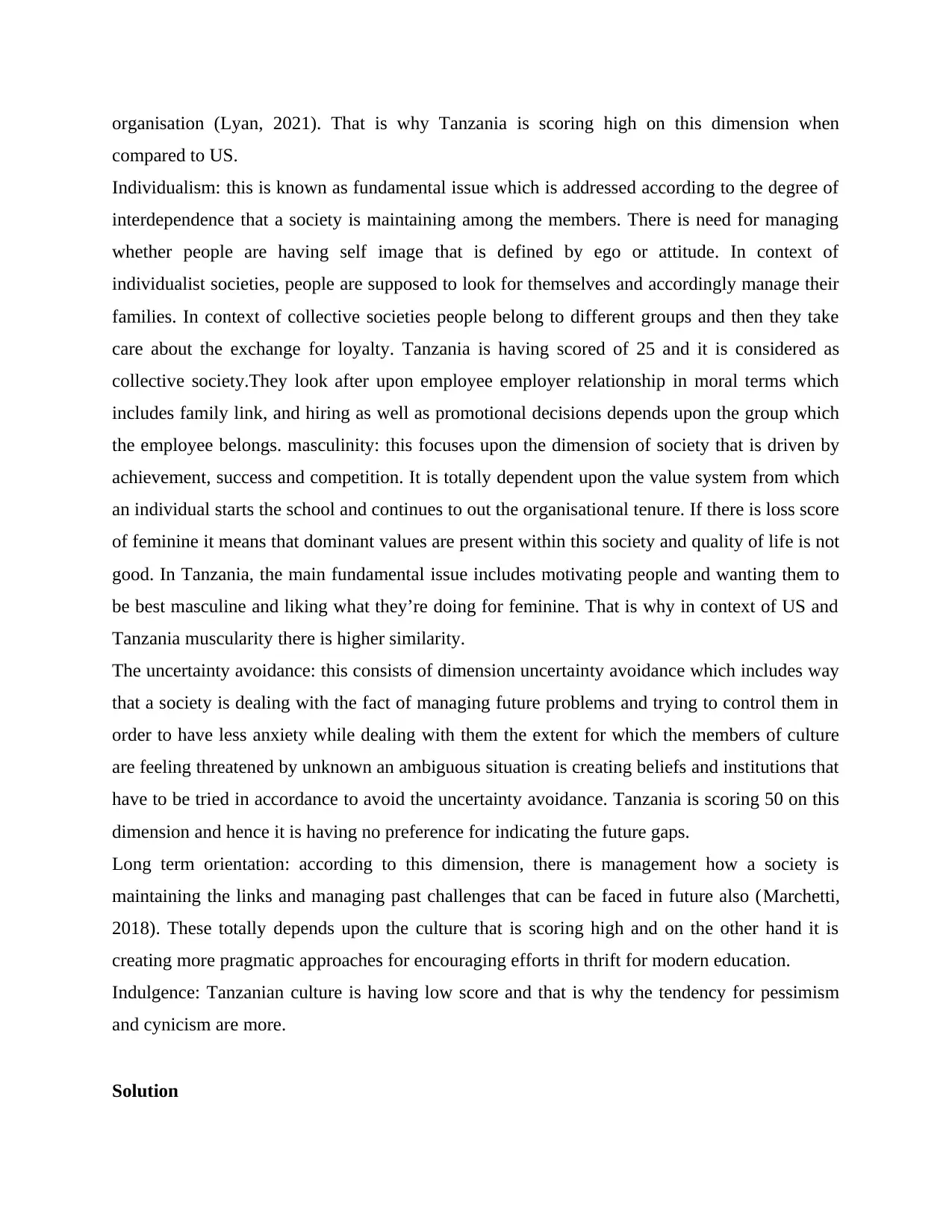
organisation (Lyan, 2021). That is why Tanzania is scoring high on this dimension when
compared to US.
Individualism: this is known as fundamental issue which is addressed according to the degree of
interdependence that a society is maintaining among the members. There is need for managing
whether people are having self image that is defined by ego or attitude. In context of
individualist societies, people are supposed to look for themselves and accordingly manage their
families. In context of collective societies people belong to different groups and then they take
care about the exchange for loyalty. Tanzania is having scored of 25 and it is considered as
collective society.They look after upon employee employer relationship in moral terms which
includes family link, and hiring as well as promotional decisions depends upon the group which
the employee belongs. masculinity: this focuses upon the dimension of society that is driven by
achievement, success and competition. It is totally dependent upon the value system from which
an individual starts the school and continues to out the organisational tenure. If there is loss score
of feminine it means that dominant values are present within this society and quality of life is not
good. In Tanzania, the main fundamental issue includes motivating people and wanting them to
be best masculine and liking what they’re doing for feminine. That is why in context of US and
Tanzania muscularity there is higher similarity.
The uncertainty avoidance: this consists of dimension uncertainty avoidance which includes way
that a society is dealing with the fact of managing future problems and trying to control them in
order to have less anxiety while dealing with them the extent for which the members of culture
are feeling threatened by unknown an ambiguous situation is creating beliefs and institutions that
have to be tried in accordance to avoid the uncertainty avoidance. Tanzania is scoring 50 on this
dimension and hence it is having no preference for indicating the future gaps.
Long term orientation: according to this dimension, there is management how a society is
maintaining the links and managing past challenges that can be faced in future also (Marchetti,
2018). These totally depends upon the culture that is scoring high and on the other hand it is
creating more pragmatic approaches for encouraging efforts in thrift for modern education.
Indulgence: Tanzanian culture is having low score and that is why the tendency for pessimism
and cynicism are more.
Solution
compared to US.
Individualism: this is known as fundamental issue which is addressed according to the degree of
interdependence that a society is maintaining among the members. There is need for managing
whether people are having self image that is defined by ego or attitude. In context of
individualist societies, people are supposed to look for themselves and accordingly manage their
families. In context of collective societies people belong to different groups and then they take
care about the exchange for loyalty. Tanzania is having scored of 25 and it is considered as
collective society.They look after upon employee employer relationship in moral terms which
includes family link, and hiring as well as promotional decisions depends upon the group which
the employee belongs. masculinity: this focuses upon the dimension of society that is driven by
achievement, success and competition. It is totally dependent upon the value system from which
an individual starts the school and continues to out the organisational tenure. If there is loss score
of feminine it means that dominant values are present within this society and quality of life is not
good. In Tanzania, the main fundamental issue includes motivating people and wanting them to
be best masculine and liking what they’re doing for feminine. That is why in context of US and
Tanzania muscularity there is higher similarity.
The uncertainty avoidance: this consists of dimension uncertainty avoidance which includes way
that a society is dealing with the fact of managing future problems and trying to control them in
order to have less anxiety while dealing with them the extent for which the members of culture
are feeling threatened by unknown an ambiguous situation is creating beliefs and institutions that
have to be tried in accordance to avoid the uncertainty avoidance. Tanzania is scoring 50 on this
dimension and hence it is having no preference for indicating the future gaps.
Long term orientation: according to this dimension, there is management how a society is
maintaining the links and managing past challenges that can be faced in future also (Marchetti,
2018). These totally depends upon the culture that is scoring high and on the other hand it is
creating more pragmatic approaches for encouraging efforts in thrift for modern education.
Indulgence: Tanzanian culture is having low score and that is why the tendency for pessimism
and cynicism are more.
Solution
Paraphrase This Document
Need a fresh take? Get an instant paraphrase of this document with our AI Paraphraser
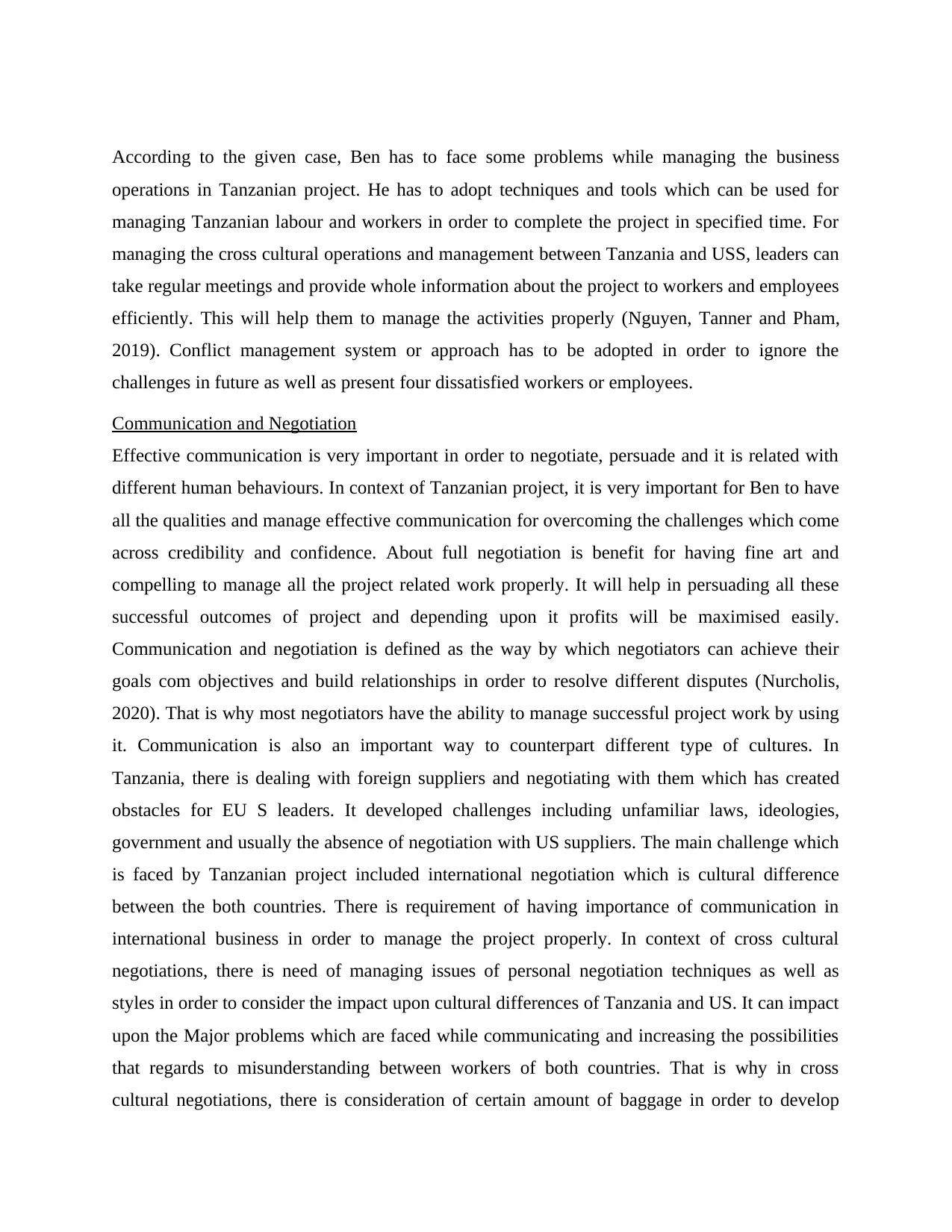
According to the given case, Ben has to face some problems while managing the business
operations in Tanzanian project. He has to adopt techniques and tools which can be used for
managing Tanzanian labour and workers in order to complete the project in specified time. For
managing the cross cultural operations and management between Tanzania and USS, leaders can
take regular meetings and provide whole information about the project to workers and employees
efficiently. This will help them to manage the activities properly (Nguyen, Tanner and Pham,
2019). Conflict management system or approach has to be adopted in order to ignore the
challenges in future as well as present four dissatisfied workers or employees.
Communication and Negotiation
Effective communication is very important in order to negotiate, persuade and it is related with
different human behaviours. In context of Tanzanian project, it is very important for Ben to have
all the qualities and manage effective communication for overcoming the challenges which come
across credibility and confidence. About full negotiation is benefit for having fine art and
compelling to manage all the project related work properly. It will help in persuading all these
successful outcomes of project and depending upon it profits will be maximised easily.
Communication and negotiation is defined as the way by which negotiators can achieve their
goals com objectives and build relationships in order to resolve different disputes (Nurcholis,
2020). That is why most negotiators have the ability to manage successful project work by using
it. Communication is also an important way to counterpart different type of cultures. In
Tanzania, there is dealing with foreign suppliers and negotiating with them which has created
obstacles for EU S leaders. It developed challenges including unfamiliar laws, ideologies,
government and usually the absence of negotiation with US suppliers. The main challenge which
is faced by Tanzanian project included international negotiation which is cultural difference
between the both countries. There is requirement of having importance of communication in
international business in order to manage the project properly. In context of cross cultural
negotiations, there is need of managing issues of personal negotiation techniques as well as
styles in order to consider the impact upon cultural differences of Tanzania and US. It can impact
upon the Major problems which are faced while communicating and increasing the possibilities
that regards to misunderstanding between workers of both countries. That is why in cross
cultural negotiations, there is consideration of certain amount of baggage in order to develop
operations in Tanzanian project. He has to adopt techniques and tools which can be used for
managing Tanzanian labour and workers in order to complete the project in specified time. For
managing the cross cultural operations and management between Tanzania and USS, leaders can
take regular meetings and provide whole information about the project to workers and employees
efficiently. This will help them to manage the activities properly (Nguyen, Tanner and Pham,
2019). Conflict management system or approach has to be adopted in order to ignore the
challenges in future as well as present four dissatisfied workers or employees.
Communication and Negotiation
Effective communication is very important in order to negotiate, persuade and it is related with
different human behaviours. In context of Tanzanian project, it is very important for Ben to have
all the qualities and manage effective communication for overcoming the challenges which come
across credibility and confidence. About full negotiation is benefit for having fine art and
compelling to manage all the project related work properly. It will help in persuading all these
successful outcomes of project and depending upon it profits will be maximised easily.
Communication and negotiation is defined as the way by which negotiators can achieve their
goals com objectives and build relationships in order to resolve different disputes (Nurcholis,
2020). That is why most negotiators have the ability to manage successful project work by using
it. Communication is also an important way to counterpart different type of cultures. In
Tanzania, there is dealing with foreign suppliers and negotiating with them which has created
obstacles for EU S leaders. It developed challenges including unfamiliar laws, ideologies,
government and usually the absence of negotiation with US suppliers. The main challenge which
is faced by Tanzanian project included international negotiation which is cultural difference
between the both countries. There is requirement of having importance of communication in
international business in order to manage the project properly. In context of cross cultural
negotiations, there is need of managing issues of personal negotiation techniques as well as
styles in order to consider the impact upon cultural differences of Tanzania and US. It can impact
upon the Major problems which are faced while communicating and increasing the possibilities
that regards to misunderstanding between workers of both countries. That is why in cross
cultural negotiations, there is consideration of certain amount of baggage in order to develop
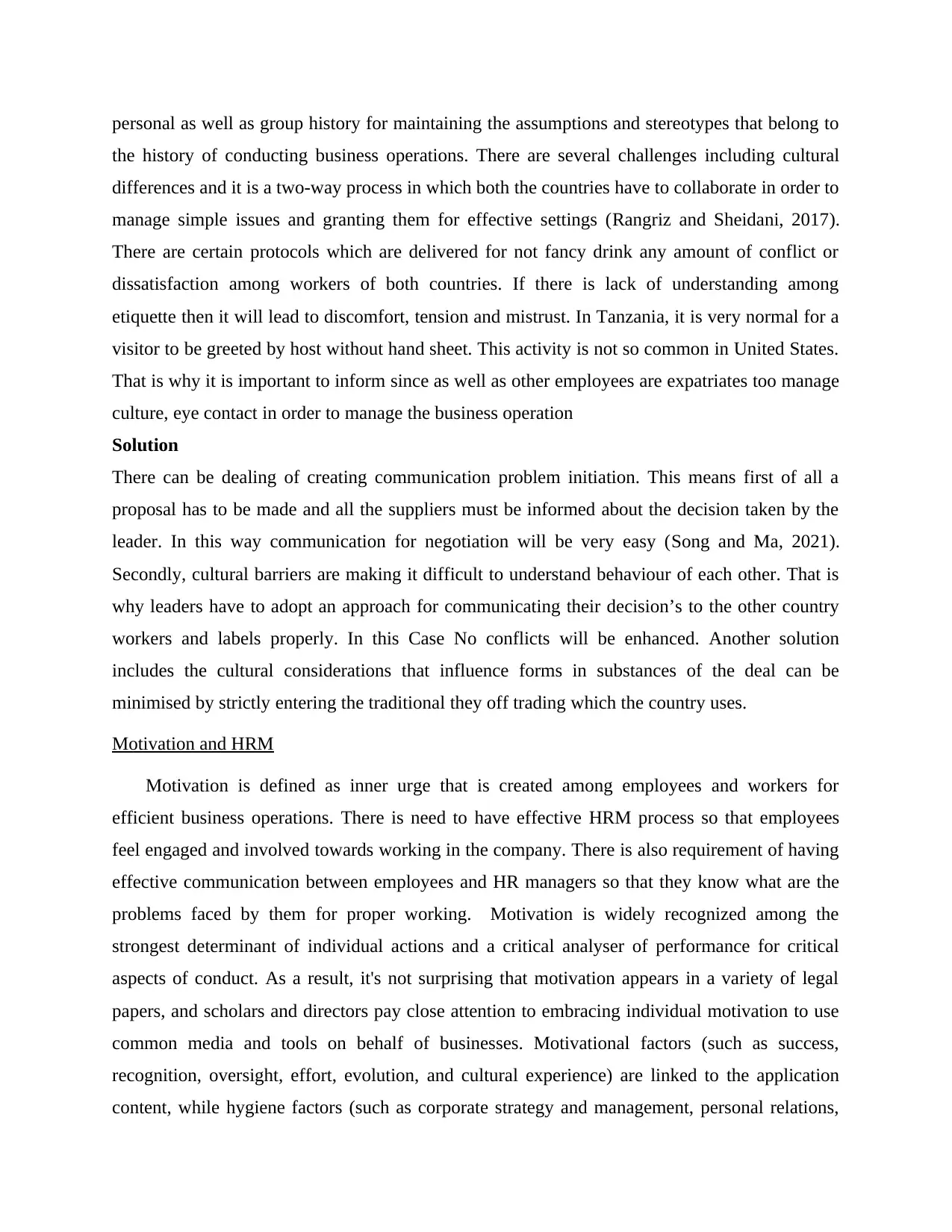
personal as well as group history for maintaining the assumptions and stereotypes that belong to
the history of conducting business operations. There are several challenges including cultural
differences and it is a two-way process in which both the countries have to collaborate in order to
manage simple issues and granting them for effective settings (Rangriz and Sheidani, 2017).
There are certain protocols which are delivered for not fancy drink any amount of conflict or
dissatisfaction among workers of both countries. If there is lack of understanding among
etiquette then it will lead to discomfort, tension and mistrust. In Tanzania, it is very normal for a
visitor to be greeted by host without hand sheet. This activity is not so common in United States.
That is why it is important to inform since as well as other employees are expatriates too manage
culture, eye contact in order to manage the business operation
Solution
There can be dealing of creating communication problem initiation. This means first of all a
proposal has to be made and all the suppliers must be informed about the decision taken by the
leader. In this way communication for negotiation will be very easy (Song and Ma, 2021).
Secondly, cultural barriers are making it difficult to understand behaviour of each other. That is
why leaders have to adopt an approach for communicating their decision’s to the other country
workers and labels properly. In this Case No conflicts will be enhanced. Another solution
includes the cultural considerations that influence forms in substances of the deal can be
minimised by strictly entering the traditional they off trading which the country uses.
Motivation and HRM
Motivation is defined as inner urge that is created among employees and workers for
efficient business operations. There is need to have effective HRM process so that employees
feel engaged and involved towards working in the company. There is also requirement of having
effective communication between employees and HR managers so that they know what are the
problems faced by them for proper working. Motivation is widely recognized among the
strongest determinant of individual actions and a critical analyser of performance for critical
aspects of conduct. As a result, it's not surprising that motivation appears in a variety of legal
papers, and scholars and directors pay close attention to embracing individual motivation to use
common media and tools on behalf of businesses. Motivational factors (such as success,
recognition, oversight, effort, evolution, and cultural experience) are linked to the application
content, while hygiene factors (such as corporate strategy and management, personal relations,
the history of conducting business operations. There are several challenges including cultural
differences and it is a two-way process in which both the countries have to collaborate in order to
manage simple issues and granting them for effective settings (Rangriz and Sheidani, 2017).
There are certain protocols which are delivered for not fancy drink any amount of conflict or
dissatisfaction among workers of both countries. If there is lack of understanding among
etiquette then it will lead to discomfort, tension and mistrust. In Tanzania, it is very normal for a
visitor to be greeted by host without hand sheet. This activity is not so common in United States.
That is why it is important to inform since as well as other employees are expatriates too manage
culture, eye contact in order to manage the business operation
Solution
There can be dealing of creating communication problem initiation. This means first of all a
proposal has to be made and all the suppliers must be informed about the decision taken by the
leader. In this way communication for negotiation will be very easy (Song and Ma, 2021).
Secondly, cultural barriers are making it difficult to understand behaviour of each other. That is
why leaders have to adopt an approach for communicating their decision’s to the other country
workers and labels properly. In this Case No conflicts will be enhanced. Another solution
includes the cultural considerations that influence forms in substances of the deal can be
minimised by strictly entering the traditional they off trading which the country uses.
Motivation and HRM
Motivation is defined as inner urge that is created among employees and workers for
efficient business operations. There is need to have effective HRM process so that employees
feel engaged and involved towards working in the company. There is also requirement of having
effective communication between employees and HR managers so that they know what are the
problems faced by them for proper working. Motivation is widely recognized among the
strongest determinant of individual actions and a critical analyser of performance for critical
aspects of conduct. As a result, it's not surprising that motivation appears in a variety of legal
papers, and scholars and directors pay close attention to embracing individual motivation to use
common media and tools on behalf of businesses. Motivational factors (such as success,
recognition, oversight, effort, evolution, and cultural experience) are linked to the application
content, while hygiene factors (such as corporate strategy and management, personal relations,
⊘ This is a preview!⊘
Do you want full access?
Subscribe today to unlock all pages.

Trusted by 1+ million students worldwide
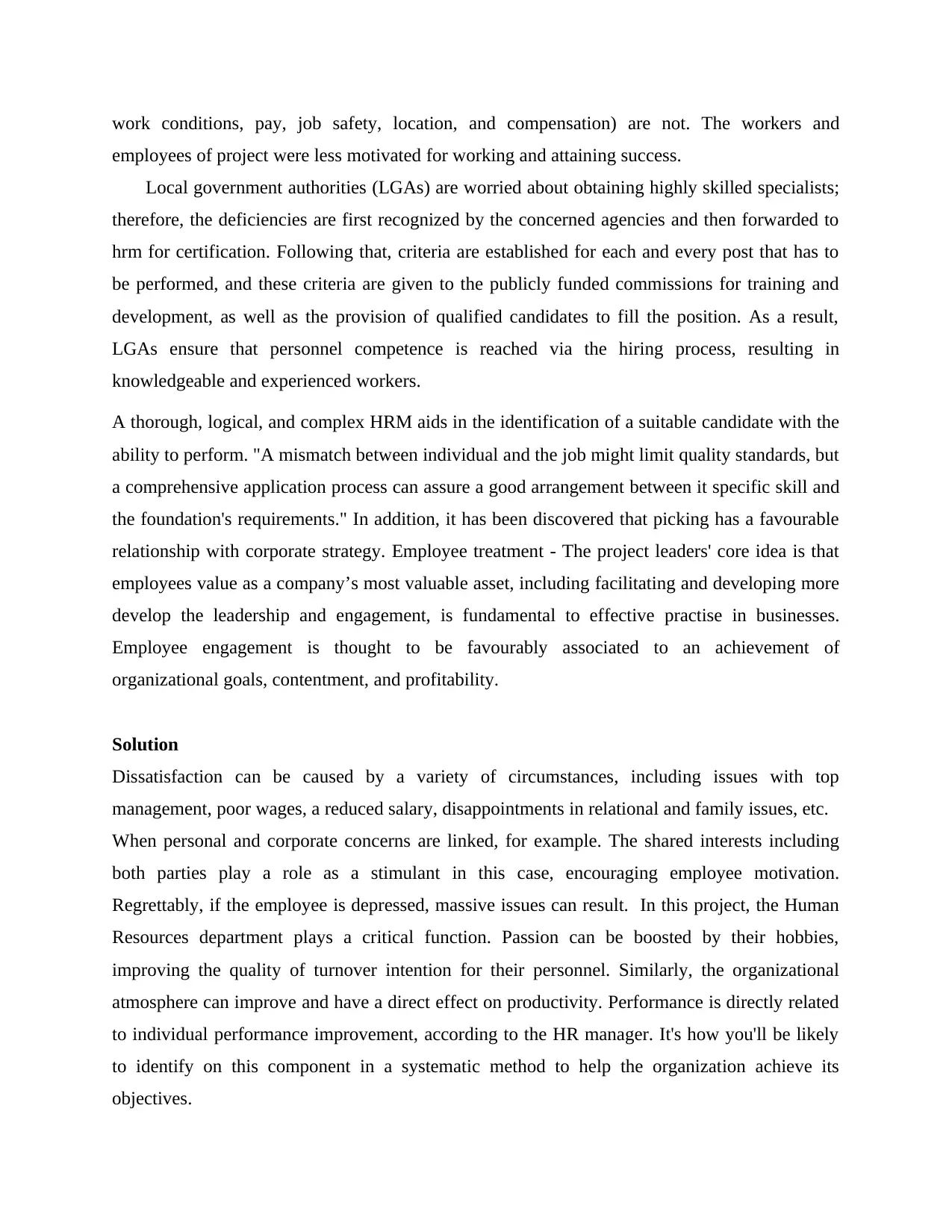
work conditions, pay, job safety, location, and compensation) are not. The workers and
employees of project were less motivated for working and attaining success.
Local government authorities (LGAs) are worried about obtaining highly skilled specialists;
therefore, the deficiencies are first recognized by the concerned agencies and then forwarded to
hrm for certification. Following that, criteria are established for each and every post that has to
be performed, and these criteria are given to the publicly funded commissions for training and
development, as well as the provision of qualified candidates to fill the position. As a result,
LGAs ensure that personnel competence is reached via the hiring process, resulting in
knowledgeable and experienced workers.
A thorough, logical, and complex HRM aids in the identification of a suitable candidate with the
ability to perform. "A mismatch between individual and the job might limit quality standards, but
a comprehensive application process can assure a good arrangement between it specific skill and
the foundation's requirements." In addition, it has been discovered that picking has a favourable
relationship with corporate strategy. Employee treatment - The project leaders' core idea is that
employees value as a company’s most valuable asset, including facilitating and developing more
develop the leadership and engagement, is fundamental to effective practise in businesses.
Employee engagement is thought to be favourably associated to an achievement of
organizational goals, contentment, and profitability.
Solution
Dissatisfaction can be caused by a variety of circumstances, including issues with top
management, poor wages, a reduced salary, disappointments in relational and family issues, etc.
When personal and corporate concerns are linked, for example. The shared interests including
both parties play a role as a stimulant in this case, encouraging employee motivation.
Regrettably, if the employee is depressed, massive issues can result. In this project, the Human
Resources department plays a critical function. Passion can be boosted by their hobbies,
improving the quality of turnover intention for their personnel. Similarly, the organizational
atmosphere can improve and have a direct effect on productivity. Performance is directly related
to individual performance improvement, according to the HR manager. It's how you'll be likely
to identify on this component in a systematic method to help the organization achieve its
objectives.
employees of project were less motivated for working and attaining success.
Local government authorities (LGAs) are worried about obtaining highly skilled specialists;
therefore, the deficiencies are first recognized by the concerned agencies and then forwarded to
hrm for certification. Following that, criteria are established for each and every post that has to
be performed, and these criteria are given to the publicly funded commissions for training and
development, as well as the provision of qualified candidates to fill the position. As a result,
LGAs ensure that personnel competence is reached via the hiring process, resulting in
knowledgeable and experienced workers.
A thorough, logical, and complex HRM aids in the identification of a suitable candidate with the
ability to perform. "A mismatch between individual and the job might limit quality standards, but
a comprehensive application process can assure a good arrangement between it specific skill and
the foundation's requirements." In addition, it has been discovered that picking has a favourable
relationship with corporate strategy. Employee treatment - The project leaders' core idea is that
employees value as a company’s most valuable asset, including facilitating and developing more
develop the leadership and engagement, is fundamental to effective practise in businesses.
Employee engagement is thought to be favourably associated to an achievement of
organizational goals, contentment, and profitability.
Solution
Dissatisfaction can be caused by a variety of circumstances, including issues with top
management, poor wages, a reduced salary, disappointments in relational and family issues, etc.
When personal and corporate concerns are linked, for example. The shared interests including
both parties play a role as a stimulant in this case, encouraging employee motivation.
Regrettably, if the employee is depressed, massive issues can result. In this project, the Human
Resources department plays a critical function. Passion can be boosted by their hobbies,
improving the quality of turnover intention for their personnel. Similarly, the organizational
atmosphere can improve and have a direct effect on productivity. Performance is directly related
to individual performance improvement, according to the HR manager. It's how you'll be likely
to identify on this component in a systematic method to help the organization achieve its
objectives.
Paraphrase This Document
Need a fresh take? Get an instant paraphrase of this document with our AI Paraphraser
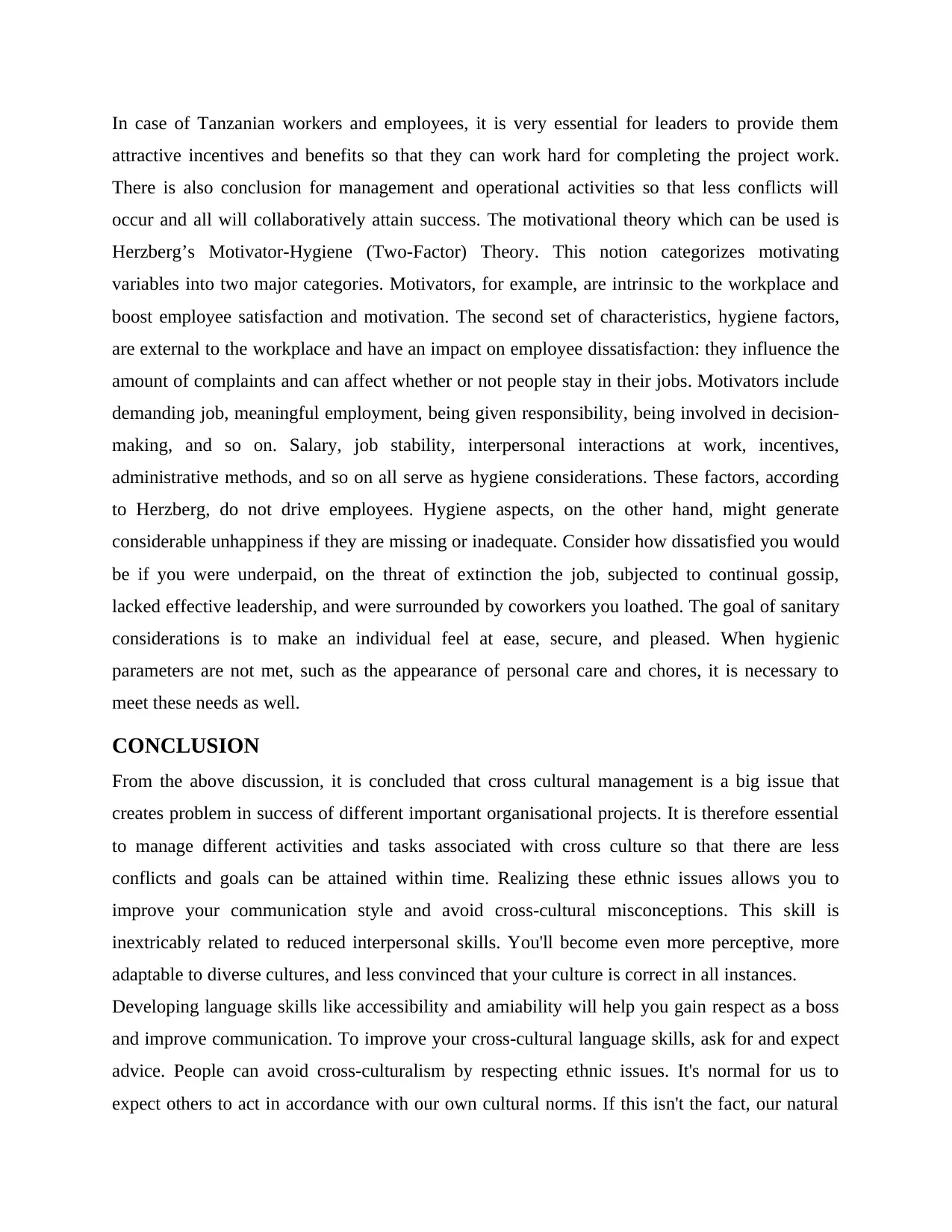
In case of Tanzanian workers and employees, it is very essential for leaders to provide them
attractive incentives and benefits so that they can work hard for completing the project work.
There is also conclusion for management and operational activities so that less conflicts will
occur and all will collaboratively attain success. The motivational theory which can be used is
Herzberg’s Motivator-Hygiene (Two-Factor) Theory. This notion categorizes motivating
variables into two major categories. Motivators, for example, are intrinsic to the workplace and
boost employee satisfaction and motivation. The second set of characteristics, hygiene factors,
are external to the workplace and have an impact on employee dissatisfaction: they influence the
amount of complaints and can affect whether or not people stay in their jobs. Motivators include
demanding job, meaningful employment, being given responsibility, being involved in decision-
making, and so on. Salary, job stability, interpersonal interactions at work, incentives,
administrative methods, and so on all serve as hygiene considerations. These factors, according
to Herzberg, do not drive employees. Hygiene aspects, on the other hand, might generate
considerable unhappiness if they are missing or inadequate. Consider how dissatisfied you would
be if you were underpaid, on the threat of extinction the job, subjected to continual gossip,
lacked effective leadership, and were surrounded by coworkers you loathed. The goal of sanitary
considerations is to make an individual feel at ease, secure, and pleased. When hygienic
parameters are not met, such as the appearance of personal care and chores, it is necessary to
meet these needs as well.
CONCLUSION
From the above discussion, it is concluded that cross cultural management is a big issue that
creates problem in success of different important organisational projects. It is therefore essential
to manage different activities and tasks associated with cross culture so that there are less
conflicts and goals can be attained within time. Realizing these ethnic issues allows you to
improve your communication style and avoid cross-cultural misconceptions. This skill is
inextricably related to reduced interpersonal skills. You'll become even more perceptive, more
adaptable to diverse cultures, and less convinced that your culture is correct in all instances.
Developing language skills like accessibility and amiability will help you gain respect as a boss
and improve communication. To improve your cross-cultural language skills, ask for and expect
advice. People can avoid cross-culturalism by respecting ethnic issues. It's normal for us to
expect others to act in accordance with our own cultural norms. If this isn't the fact, our natural
attractive incentives and benefits so that they can work hard for completing the project work.
There is also conclusion for management and operational activities so that less conflicts will
occur and all will collaboratively attain success. The motivational theory which can be used is
Herzberg’s Motivator-Hygiene (Two-Factor) Theory. This notion categorizes motivating
variables into two major categories. Motivators, for example, are intrinsic to the workplace and
boost employee satisfaction and motivation. The second set of characteristics, hygiene factors,
are external to the workplace and have an impact on employee dissatisfaction: they influence the
amount of complaints and can affect whether or not people stay in their jobs. Motivators include
demanding job, meaningful employment, being given responsibility, being involved in decision-
making, and so on. Salary, job stability, interpersonal interactions at work, incentives,
administrative methods, and so on all serve as hygiene considerations. These factors, according
to Herzberg, do not drive employees. Hygiene aspects, on the other hand, might generate
considerable unhappiness if they are missing or inadequate. Consider how dissatisfied you would
be if you were underpaid, on the threat of extinction the job, subjected to continual gossip,
lacked effective leadership, and were surrounded by coworkers you loathed. The goal of sanitary
considerations is to make an individual feel at ease, secure, and pleased. When hygienic
parameters are not met, such as the appearance of personal care and chores, it is necessary to
meet these needs as well.
CONCLUSION
From the above discussion, it is concluded that cross cultural management is a big issue that
creates problem in success of different important organisational projects. It is therefore essential
to manage different activities and tasks associated with cross culture so that there are less
conflicts and goals can be attained within time. Realizing these ethnic issues allows you to
improve your communication style and avoid cross-cultural misconceptions. This skill is
inextricably related to reduced interpersonal skills. You'll become even more perceptive, more
adaptable to diverse cultures, and less convinced that your culture is correct in all instances.
Developing language skills like accessibility and amiability will help you gain respect as a boss
and improve communication. To improve your cross-cultural language skills, ask for and expect
advice. People can avoid cross-culturalism by respecting ethnic issues. It's normal for us to
expect others to act in accordance with our own cultural norms. If this isn't the fact, our natural

reaction is to dismiss it. Managers and leaders really shouldn't be frustrated by behaviour driven
by differing cultural norms, notwithstanding how difficult this is to achieve. Opening up to
cultural differences is one method to combat this. Rather than acting with prejudices, ask
questions about the beliefs that guide specific behaviours. It should also assist you in resolving
conflicts in a more empathetic and understanding way.
by differing cultural norms, notwithstanding how difficult this is to achieve. Opening up to
cultural differences is one method to combat this. Rather than acting with prejudices, ask
questions about the beliefs that guide specific behaviours. It should also assist you in resolving
conflicts in a more empathetic and understanding way.
⊘ This is a preview!⊘
Do you want full access?
Subscribe today to unlock all pages.

Trusted by 1+ million students worldwide
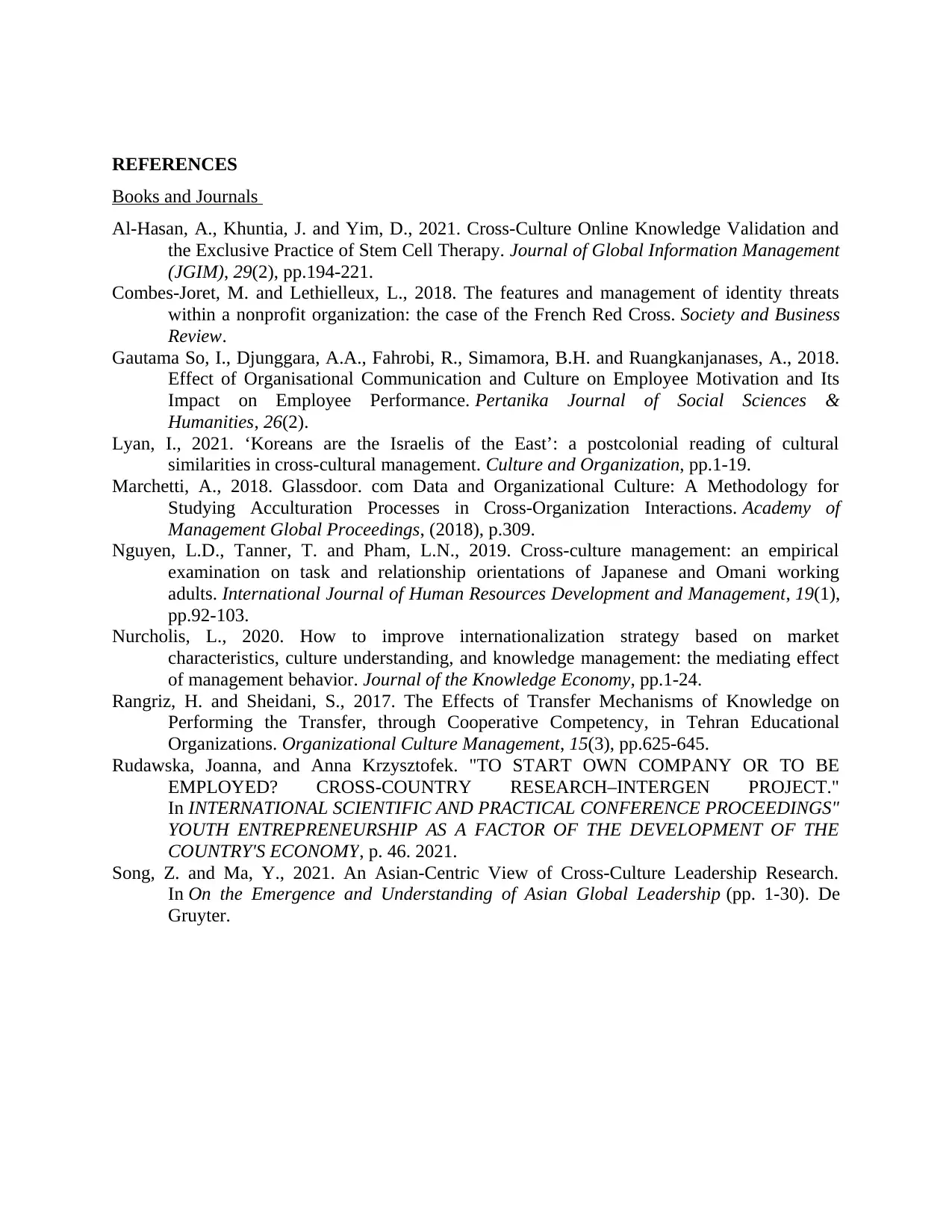
REFERENCES
Books and Journals
Al-Hasan, A., Khuntia, J. and Yim, D., 2021. Cross-Culture Online Knowledge Validation and
the Exclusive Practice of Stem Cell Therapy. Journal of Global Information Management
(JGIM), 29(2), pp.194-221.
Combes-Joret, M. and Lethielleux, L., 2018. The features and management of identity threats
within a nonprofit organization: the case of the French Red Cross. Society and Business
Review.
Gautama So, I., Djunggara, A.A., Fahrobi, R., Simamora, B.H. and Ruangkanjanases, A., 2018.
Effect of Organisational Communication and Culture on Employee Motivation and Its
Impact on Employee Performance. Pertanika Journal of Social Sciences &
Humanities, 26(2).
Lyan, I., 2021. ‘Koreans are the Israelis of the East’: a postcolonial reading of cultural
similarities in cross-cultural management. Culture and Organization, pp.1-19.
Marchetti, A., 2018. Glassdoor. com Data and Organizational Culture: A Methodology for
Studying Acculturation Processes in Cross-Organization Interactions. Academy of
Management Global Proceedings, (2018), p.309.
Nguyen, L.D., Tanner, T. and Pham, L.N., 2019. Cross-culture management: an empirical
examination on task and relationship orientations of Japanese and Omani working
adults. International Journal of Human Resources Development and Management, 19(1),
pp.92-103.
Nurcholis, L., 2020. How to improve internationalization strategy based on market
characteristics, culture understanding, and knowledge management: the mediating effect
of management behavior. Journal of the Knowledge Economy, pp.1-24.
Rangriz, H. and Sheidani, S., 2017. The Effects of Transfer Mechanisms of Knowledge on
Performing the Transfer, through Cooperative Competency, in Tehran Educational
Organizations. Organizational Culture Management, 15(3), pp.625-645.
Rudawska, Joanna, and Anna Krzysztofek. "TO START OWN COMPANY OR TO BE
EMPLOYED? CROSS-COUNTRY RESEARCH–INTERGEN PROJECT."
In INTERNATIONAL SCIENTIFIC AND PRACTICAL CONFERENCE PROCEEDINGS"
YOUTH ENTREPRENEURSHIP AS A FACTOR OF THE DEVELOPMENT OF THE
COUNTRY'S ECONOMY, p. 46. 2021.
Song, Z. and Ma, Y., 2021. An Asian-Centric View of Cross-Culture Leadership Research.
In On the Emergence and Understanding of Asian Global Leadership (pp. 1-30). De
Gruyter.
Books and Journals
Al-Hasan, A., Khuntia, J. and Yim, D., 2021. Cross-Culture Online Knowledge Validation and
the Exclusive Practice of Stem Cell Therapy. Journal of Global Information Management
(JGIM), 29(2), pp.194-221.
Combes-Joret, M. and Lethielleux, L., 2018. The features and management of identity threats
within a nonprofit organization: the case of the French Red Cross. Society and Business
Review.
Gautama So, I., Djunggara, A.A., Fahrobi, R., Simamora, B.H. and Ruangkanjanases, A., 2018.
Effect of Organisational Communication and Culture on Employee Motivation and Its
Impact on Employee Performance. Pertanika Journal of Social Sciences &
Humanities, 26(2).
Lyan, I., 2021. ‘Koreans are the Israelis of the East’: a postcolonial reading of cultural
similarities in cross-cultural management. Culture and Organization, pp.1-19.
Marchetti, A., 2018. Glassdoor. com Data and Organizational Culture: A Methodology for
Studying Acculturation Processes in Cross-Organization Interactions. Academy of
Management Global Proceedings, (2018), p.309.
Nguyen, L.D., Tanner, T. and Pham, L.N., 2019. Cross-culture management: an empirical
examination on task and relationship orientations of Japanese and Omani working
adults. International Journal of Human Resources Development and Management, 19(1),
pp.92-103.
Nurcholis, L., 2020. How to improve internationalization strategy based on market
characteristics, culture understanding, and knowledge management: the mediating effect
of management behavior. Journal of the Knowledge Economy, pp.1-24.
Rangriz, H. and Sheidani, S., 2017. The Effects of Transfer Mechanisms of Knowledge on
Performing the Transfer, through Cooperative Competency, in Tehran Educational
Organizations. Organizational Culture Management, 15(3), pp.625-645.
Rudawska, Joanna, and Anna Krzysztofek. "TO START OWN COMPANY OR TO BE
EMPLOYED? CROSS-COUNTRY RESEARCH–INTERGEN PROJECT."
In INTERNATIONAL SCIENTIFIC AND PRACTICAL CONFERENCE PROCEEDINGS"
YOUTH ENTREPRENEURSHIP AS A FACTOR OF THE DEVELOPMENT OF THE
COUNTRY'S ECONOMY, p. 46. 2021.
Song, Z. and Ma, Y., 2021. An Asian-Centric View of Cross-Culture Leadership Research.
In On the Emergence and Understanding of Asian Global Leadership (pp. 1-30). De
Gruyter.
1 out of 10
Related Documents
Your All-in-One AI-Powered Toolkit for Academic Success.
+13062052269
info@desklib.com
Available 24*7 on WhatsApp / Email
![[object Object]](/_next/static/media/star-bottom.7253800d.svg)
Unlock your academic potential
Copyright © 2020–2025 A2Z Services. All Rights Reserved. Developed and managed by ZUCOL.



